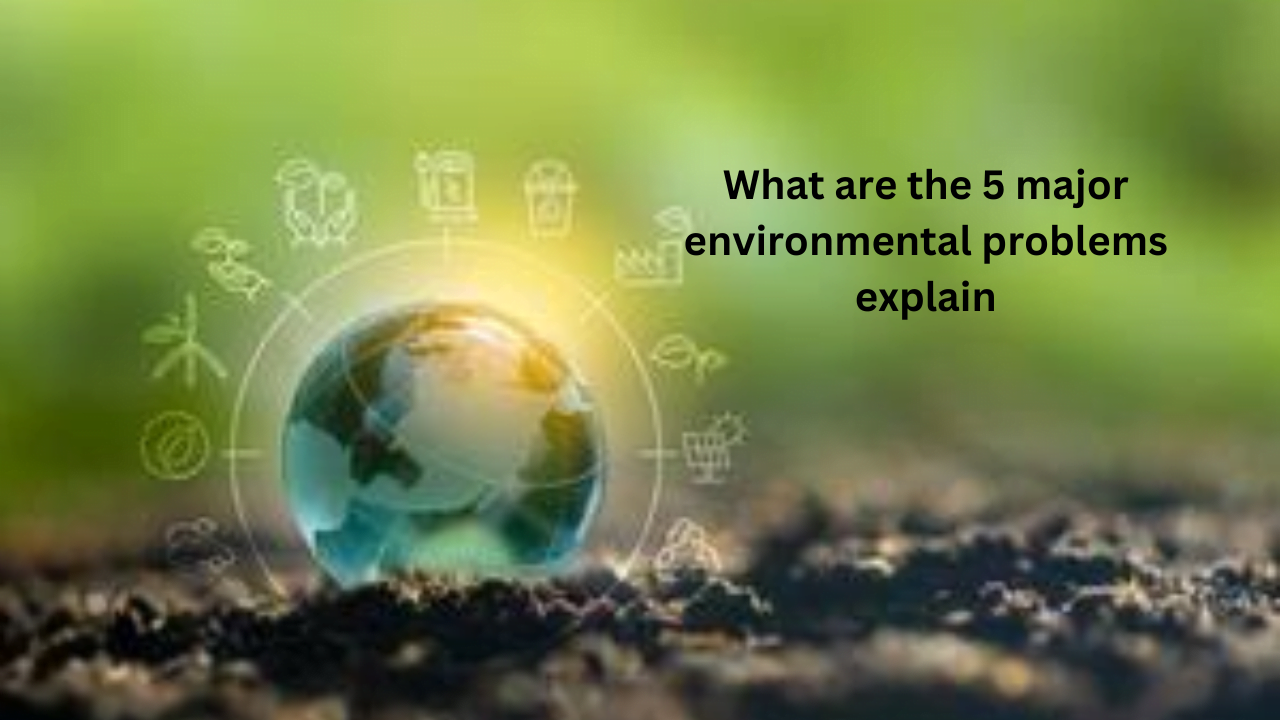The Earth, our vibrant blue marble, sustains life in all its wondrous diversity. Yet, nestled within this beauty lies a growing shadow, a grim symphony of environmental challenges threatening the very fabric of our existence. While numerous issues plague our planet, five major environmental problems demand immediate attention and concerted action.
Five Earth-Shaking Threats: The Environmental Battles We Must Win
- Climate Change: The Looming Storm
Rising global temperatures, driven by the accumulation of greenhouse gases like carbon dioxide, stand as the most pressing environmental threat. Burning fossil fuels, deforestation, and industrial processes are the primary culprits, releasing these gases into the atmosphere and trapping heat. Consequences abound: melting glaciers and ice caps, rising sea levels inundating coastal communities, extreme weather events like droughts, floods, and heatwaves becoming more frequent and intense.
The cascading effects of climate change are already being felt worldwide, disrupting ecosystems, displacing populations, and jeopardizing food security. If left unchecked, it could plunge countless species into extinction, trigger mass migrations, and destabilize entire regions. The window for mitigating these impacts is rapidly closing, demanding a global shift towards renewable energy sources, sustainable practices, and carbon capture technologies.
On the Brink: Can We Survive These 5 Looming Environmental Crises
- Plastic Pollution: A Choking Sea and Suffocating Land
From the deepest ocean trenches to the highest mountain peaks, plastic has become ubiquitous, a testament to our throwaway culture. Every year, millions of tons of plastic waste flood our environment, with single-use items like straws, bags, and bottles constituting a significant portion. This plastic debris entangles and kills marine life, contaminates food chains, and pollutes freshwater sources.
On land, plastic clogs landfills, releasing harmful chemicals into the soil and leaching into groundwater. Microplastics, formed from the breakdown of larger plastic fragments, are now found everywhere, from Arctic ice to human placentas. Their long-term impacts on human health and ecosystems remain largely unknown, but the potential risks are alarming.
To tackle this plastic plague, transitioning to sustainable alternatives, embracing responsible waste management systems, and promoting consumer awareness are crucial. Reducing single-use plastics, investing in biodegradable materials, and fostering innovative recycling solutions are essential steps towards reclaiming our planet from this plastic scourge.
Code Red for Planet Earth: A Wake-Up Call to Face the Five Biggest Environmental Threats
- Biodiversity Loss: The Web Untangling
The tapestry of life on Earth is intricately woven, with each species playing a vital role in maintaining the delicate balance of ecosystems. Sadly, this tapestry is rapidly unraveling due to habitat loss, deforestation, climate change, and human exploitation. Unsustainable agricultural practices, invasive species introductions, and pollution are pushing countless species towards extinction.
Climate Change, Plastic Pollution, Biodiversity Loss, Water Scarcity, Pollution: The Five Faces of Environmental Crisis
The loss of biodiversity has far-reaching consequences. Pollination crucial for food production declines, natural pest control mechanisms falter, and the resilience of ecosystems to withstand environmental changes diminishes. Furthermore, the extinction of unique species represents an incalculable loss of genetic diversity and the potential for future discoveries.
Protecting biodiversity demands a multifaceted approach. Establishing and expanding protected areas, promoting sustainable land-use practices, combating illegal wildlife trade, and conserving genetic diversity are crucial steps in safeguarding the web of life. Recognizing the intrinsic value of every species and fostering a deeper respect for nature are fundamental to ensuring a vibrant future for all.
From Rising Seas to Poisoned Ecosystems: Exploring the Scope and Solutions to the Top 5 Environmental Challenges
- Water Scarcity: A Precious Drop in a Dry World
Freshwater, the very elixir of life, is becoming increasingly scarce. While water covers 71% of Earth’s surface, only 2.5% is freshwater, and much of that is inaccessible or polluted. Climate change, population growth, and unsustainable water use are rapidly outpacing replenishment rates, pushing millions towards water scarcity.
Droughts parch farmland, depleting food production. Groundwater tables plummet, jeopardizing drinking water supplies. Competition for this precious resource fuels conflicts both local and international. The consequences of water scarcity are dire, impacting every aspect of human life and threatening the stability of entire regions.
Investing in water-efficient technologies, promoting sustainable agricultural practices, and managing water resources responsibly are essential steps to ensure equitable access to clean water for all. Conserving water at the individual level, tackling leaky infrastructure, and exploring alternative water sources like desalination can collectively turn the tide against this growing crisis.
- Pollution: A Toxic Grip on Our Planet
From the belching smokestacks of factories to the exhaust pipes of vehicles, pollution casts a toxic shadow over our planet. Air pollution, primarily caused by the burning of fossil fuels, chokes cities, triggers respiratory illnesses, and contributes to climate change. Water pollution, fueled by industrial waste, agricultural runoff, and untreated sewage, poisons waterways, disrupts ecosystems, and threatens human health.
Soil pollution, arising from excessive pesticide and fertilizer use, contaminates food sources and weakens the fertility of our land. The sheer volume and diversity of pollutants released into the environment pose a formidable challenge, demanding immediate action on multiple fronts.
Transitioning to renewable energy sources, implementing stricter emission regulations, and promoting sustainable transportation options are crucial for
